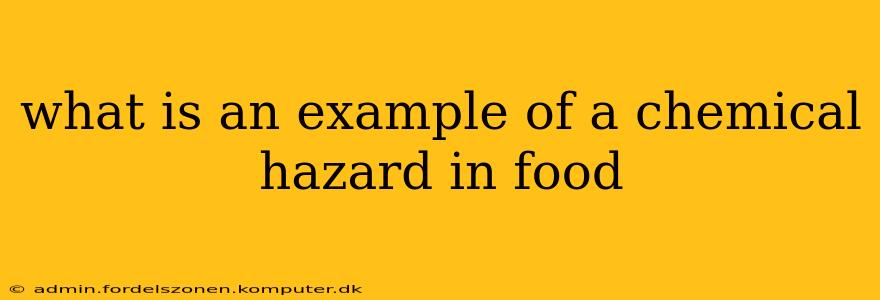What is an Example of a Chemical Hazard in Food?
Chemical hazards in food are substances that can cause harm if ingested. These hazards can be naturally occurring, unintentionally added during processing, or deliberately added (though this is often illegal). Understanding these risks is crucial for food safety. Let's explore some examples.
What are some examples of chemical hazards in food?
Many chemicals pose risks to food safety. Some examples include:
-
Pesticide residues: Fruits and vegetables often contain traces of pesticides used during cultivation. While regulated to ensure levels are below harmful thresholds, excessive residues or exposure to particularly toxic pesticides can lead to health problems. The specific pesticides and their concentrations vary greatly depending on the produce and farming practices.
-
Heavy metals: Heavy metals like lead, mercury, arsenic, and cadmium can contaminate food through various pathways. Soil contamination, industrial pollution, and even certain food packaging can introduce these toxins. These heavy metals accumulate in the body and can cause severe health issues, including neurological damage. Seafood, especially shellfish, can be a source of mercury contamination.
-
Mycotoxins: These are toxic substances produced by certain molds that can grow on food crops such as grains, nuts, and fruits. Aflatoxins, for example, are potent carcinogens produced by Aspergillus molds and can contaminate peanuts, corn, and other foods.
-
Acrylamide: This chemical forms naturally in starchy foods, like potatoes and bread, when cooked at high temperatures (frying, baking, roasting). While its toxicity is still being researched, studies have linked acrylamide to increased cancer risk.
-
Additives: While many food additives are rigorously tested and deemed safe, some may cause adverse reactions in sensitive individuals. Artificial colors, preservatives, and flavor enhancers are common examples. Reactions can vary from mild allergic responses to more severe health complications.
-
Cleaning and sanitizing chemicals: Improper cleaning and sanitation practices can lead to the contamination of food with cleaning agents. These chemicals are not meant for consumption and can cause illness or harm if ingested.
-
Packaging materials: Some food packaging materials can leach chemicals into the food, especially when exposed to heat or prolonged storage. This is a concern with certain plastics and coatings.
How are chemical hazards in food identified and controlled?
Government regulatory agencies, like the FDA (in the US) and the EFSA (in Europe), play a vital role in monitoring and regulating chemical hazards in food. They set maximum residue limits (MRLs) for pesticides and other contaminants to minimize risks. Food manufacturers also implement Hazard Analysis and Critical Control Points (HACCP) systems to identify and control potential hazards throughout the food production process.
What are the effects of chemical hazards on human health?
The effects of chemical hazards in food can range from mild gastrointestinal upset to severe chronic illnesses, including cancer, neurological damage, and reproductive problems. The severity depends on the specific chemical, the amount ingested, and the individual's health status. Symptoms can manifest immediately or after prolonged exposure.
How can I reduce my exposure to chemical hazards in food?
Consumers can take several steps to reduce their exposure:
-
Wash produce thoroughly: Washing fruits and vegetables under running water can help remove pesticide residues and other surface contaminants.
-
Choose organic options: Organic farming practices generally use fewer pesticides, although complete avoidance of all chemicals isn't guaranteed.
-
Vary your diet: A diverse diet reduces reliance on a single food source, which might be more prone to contamination.
-
Cook at lower temperatures: Minimizing high-temperature cooking methods like frying can reduce the formation of acrylamide.
-
Choose less processed foods: Processed foods often contain more additives and preservatives.
-
Store food properly: Proper storage can prevent contamination and reduce chemical leaching from packaging.
By understanding the potential chemical hazards present in our food supply and following safe food handling practices, we can significantly reduce our risk of exposure and promote better health. Always look for information about the origin and processing methods of the food you choose, and consult your healthcare provider if you have concerns about food safety.
